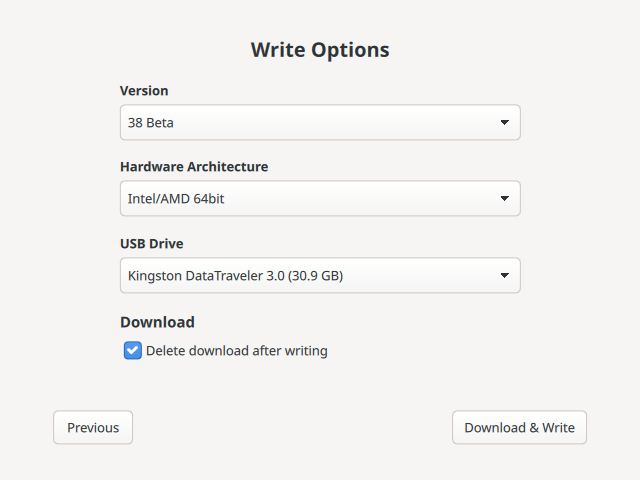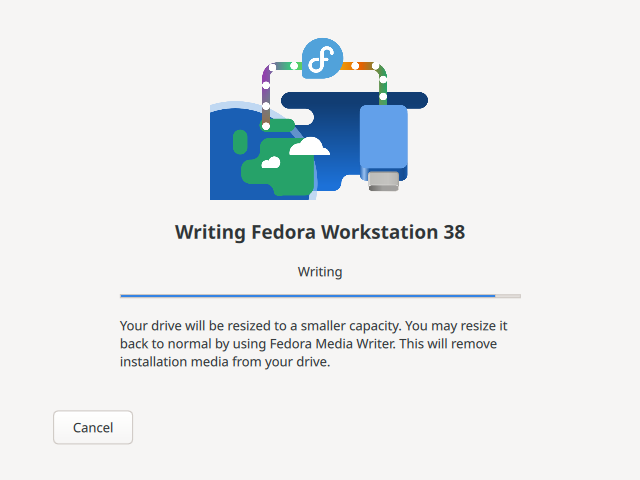Préparation du support de démarrage
Les images de Fedora sont des « ISO hybrides » et peuvent être utilisées pour créer un support d’installation sur CD/DVD ou clé USB utilisable à la fois sur les systèmes BIOS et UEFI.
Fedora Media Writer
Fedora Media Writer a été considérablement amélioré et constitue désormais le processus officiel, testé et pris en charge de création de support de démarrage. Fedora Media Writer prend en charge Linux, macOS et Windows. Il vous permet de créer facilement un support de démarrage USB pour installer Fedora (ou d’autres systèmes d’exploitation). L’utilisation de Fedora Media Writer est fortement encouragée, bien que d’autres logiciels de création de supports USB puissent également fonctionner.
Il est désormais possible de sélectionner directement Fedora Workstation et Server depuis l’écran principal de Fedora Media Writer. D’autres choix sont disponibles en sélectionnant Image personnalisée. Vous pourrez alors sélectionner divers Spins de Fedora, tels que Xfce ou Mate.
Historiquement, les outils de création USB universels, tels que Unetbootin, étaient souvent utilisés pour créer des programmes d’installation USB à partir d’ISO destinés aux supports CD/DVD. Généralement, ces outils créaient un système de fichiers sur la clé USB en extrayant les fichiers de l’image et en écrivant le bootloader syslinux sur le périphérique.
Ces méthodes contournent la configuration du bootloader intégrée aux images de Fedora, qui sont prépartitionnées et conçues pour démarrer sur les systèmes UEFI avec Secure Boot activé tout comme sur les systèmes BIOS. Ces méthodes peuvent donc poser problème avec les images de Fedora, en particulier sur les systèmes UEFI.
Vous obtiendrez les meilleurs résultats avec des utilitaires utilisant une méthode d’écriture directe qui ne modifie pas l’image Fedora.
|
Réfléchissez toujours à deux fois avant d’écrire une image sur un périphérique. Les méthodes de création de support décrites dans cet article détruisent les données existantes. Toutes les données de la clé USB sont supprimées lors du processus, assurez-vous donc d’avoir une sauvegarde des données de la clé USB. Vérifiez par deux fois que vous avez sélectionné le bon périphérique sur lequel écrire l’image ! |
Installation et exécution de Fedora Media Writer
Sur Fedora
Sur Fedora 25 et ultérieur, Fedora Media Writer est disponible dans le dépôt par défaut. Vous pouvez utiliser dnf pour installer le paquet.
-
Pour installer Fedora Media Writer :
$ sudo dnf install mediawriter -
Pour exécuter Fedora Media Writer :
$ mediawriterou dans GNOME, sélectionnez Activités puis cliquez sur Fedora Media Writer.
Sur les autres distributions Linux
La meilleure manière d’installer Fedora Media Writer sur la plupart des distributions Linux est d’utiliser le paquet Flatpak précompilé. Le paquet peut être obtenu depuis le dépôt Flatpak officiel Flathub.org.
-
Pour installer Flatpak sur votre système Linux, suivez les instructions dans la documentation Flatpak.
-
Exécutez l’application :
$ sudo mediawriter
Sur Windows
-
Téléchargez le dernier fichier pour Windows Installer à partir de fedoraproject.org. Le serveur détermine automatiquement le système utilisé et vous fournit le fichier d’installation adapté à votre version de Windows.
-
Démarrez l’installation en double-cliquant sur le fichier téléchargé, puis suivez les étapes de l’assistant d’installation. Ce dernier vous permet de personnaliser l’installation si vous le souhaitez.
-
Exécutez l’application, par exemple à l’aide d’un raccourci.
Dans Windows 8 et 10, Fedora Media Writer se trouve dans le menu Toutes les applications à la lettre F. Dans Windows 10, vous pouvez simplement taper Fedora Media Writer dans la barre de recherche située sur la barre des tâches.
Si vous recevez une erreur à propos d’un fichier .dll manquant (le package redistribuable MSVC), la bibliothèque requise peut être obtenue à partir d’ici : Téléchargements des dernières versions de Microsoft Visual C++ Redistributable.
Sur macOS
-
Téléchargez la dernière image disque Macintosh (le paquet portera l’extension .dmg) à partir de fedoraproject.org. Le serveur détermine automatiquement le système utilisé et vous fournit le paquet adapté à votre version de macOS.
-
Ouvrez le fichier
.dmget maintenez la touche kbd:[Ctrl] enfoncée en cliquant sur l’application Fedora Media Writer. -
Appuyez sur “Ouvrir” dans le menu pop-up.
-
Cliquez sur le bouton “Ouvrir” dans la fenêtre de confirmation, si elle apparaît.
Écriture de l’image ISO sur le support USB
-
Sélectionnez l’Édition Fedora que vous souhaitez utiliser pour la création d’un lecteur USB bootable.
 Figure 1. Écran principal de Fedora Media Writer : choisissez votre Édition de Fedora
Figure 1. Écran principal de Fedora Media Writer : choisissez votre Édition de FedoraL’écran principal vous permet de choisir l’une des Éditions courantes de Fedora, Fedora Workstation ou Fedora Server. Fedora Media Writer affiche plus de détails à propos de l’Édition avant que vous ne puissiez poursuivre avec le téléchargement de l’image et la création du support USB. Vous pouvez choisir une architecture différente en sélectionnant d’autres variantes.
-
Sélectionnez “Créer un Live USB” pour continuer.
 Figure 2. Fedora Media Writer Distro Information
Figure 2. Fedora Media Writer Distro InformationFedora Media Writer téléchargera automatiquement l’ISO pour vous. Si vous avez déjà téléchargé l’ISO et l’avez placée dans le répertoire Téléchargements, il sera immédiatement utilisable.
 Figure 3. Fedora Media Writer Automatic Download
Figure 3. Fedora Media Writer Automatic Download -
Plug in a USB drive on which you want to create the bootable media.
-
To write the image onto the media, click the red btn:[Write to disk] button.
 Figure 4. Fedora Media Writer Write to USB Device
Figure 4. Fedora Media Writer Write to USB Device
Other methods to create a live USB
Using the Fedora Media Writer is highly recommended for everybody, because it offers a reliable way to create a live USB stick for Fedora installation.
However, some experienced users may prefer to go through the creation process manually. If you decide to do so, you have to download the installation images and use an application to write them onto the USB stick.
|
If you have downloaded and verified the installation images manually, you still can write them onto the USB stick using Fedora Media Writer. |
Downloading Boot and Installation Images
The Fedora Project offers different Editions tailored for some specific use cases. Choose the Fedora Edition best for you. You can also build your own by customizing Fedora after it’s installed or by using a kickstart file as described in Creating a Kickstart File.
Kickstart installation requires the netinstall media type, or a direct installation booting method such as PXE; kickstarts are not supported with live images.
Read more about Fedora Workstation, Fedora Cloud, Fedora Server and the available media types in Downloading Fedora.
You can also choose a Fedora Spin featuring favorite alternative desktops or tools for specialized tasks at https://spins.fedoraproject.org.
Vérification en cours de l’image téléchargée
Because transmission errors or other problems may corrupt the Fedora image you have downloaded, it is important to verify the file’s integrity. After the images are created, an operation is performed on the file that produces a value called a checksum using a complex mathematical algorithm. The operation is sufficiently complex that any change to the original file will produce a different checksum.
By calculating the image’s checksum on your own computer and comparing it to the original checksum, you can verify the image has not been tampered with or corrupted. The original checksum values are provided at https://fedoraproject.org/security/, and are gpg signed to demonstrate their integrity.
Verifying checksums on Windows systems
-
Download the Fedora image of your choice from https://fedoraproject.org/ and the corresponding checksum file from https://fedoraproject.org/security/
-
Open a powershell session.
-
Change to the directory containing the downloaded files.
> cd $HOME\Downloads\ > ls Directory: C:\Users\Pete\Downloads Mode LastWriteTime Length Name ---- ------------- ------ ---- -a--- 11/25/2014 12:39 PM 272 Fedora-Server-21-x86_64-CHECKSUM -a--- 11/25/2014 12:39 PM 2047868928 Fedora-Server-DVD-x86_64-21.iso
-
Paste the following function to powershell for calculating and comparing checksums.
function Get-ImageVerification(){ param( [Parameter(Mandatory=$true, Position=0)] [string]$ImageFilePath, [Parameter(Mandatory=$true, Position=1)] [string]$ChecksumFilePath ) $expected_checksum = ((Get-Content $ChecksumFilePath | Select-String -Pattern (Split-Path $ImageFilePath -leaf)) -split " ")[-1].ToLower() $download_checksum = (Get-FileHash -Path $ImageFilePath -Algorithm SHA256).Hash.ToLower() echo "Download Checksum: $download_checksum" echo "Expected Checksum: $expected_checksum" if ( $download_checksum -eq "$expected_checksum" ) { echo "Checksum test passed!" } else { echo "Checksum test failed." } } -
Execute the function pasted in previous step
Get-ImageVerification .\Fedora-Server-DVD-x86_64-21.iso .\Fedora-Server-DVD-x86_64-21.iso
Verifying checksums on Linux and macOS systems
-
Download the Fedora image of your choice from https://fedoraproject.org/get-fedora and the corresponding checksum file from https://fedoraproject.org/security/
-
Open a terminal window, and navigate to the directory with the downloaded files.
$ cd ~/Downloads -
Use the appropriate utility to verify the image checksum.
-
For Linux:
$ sha256sum -c *CHECKSUM
-
For macOS:
$ grep '^SHA256' *-CHECKSUM | awk -F '[()=]' '{ print $4 " " $2 }' | shasum -a 256 -c
-
Writing the images to USB media
Creating USB media with GNOME Disks
-
On a system with GNOME, or with the gnome-disk-utility package installed, open
Disksusing the system menu. -
Click your USB device in the left column.
-
Click the menu icon in the upper right corner of the window, and choose the
Restore Disk Imageoption. -
Navigate to your image file and click
Start Restoring. After a few minutes, it will report the process is complete and your installation media will be ready to use.
Creating USB Media on the Linux command line
-
Open a terminal window and insert the usb drive.
-
Find the
device nodeassigned to the drive. In the example below, the drive is givensdd.$ dmesg|tail [288954.686557] usb 2-1.8: New USB device strings: Mfr=0, Product=1, SerialNumber=2 [288954.686559] usb 2-1.8: Product: USB Storage [288954.686562] usb 2-1.8: SerialNumber: 000000009225 [288954.712590] usb-storage 2-1.8:1.0: USB Mass Storage device detected [288954.712687] scsi host6: usb-storage 2-1.8:1.0 [288954.712809] usbcore: registered new interface driver usb-storage [288954.716682] usbcore: registered new interface driver uas [288955.717140] scsi 6:0:0:0: Direct-Access Generic STORAGE DEVICE 9228 PQ: 0 ANSI: 0 [288955.717745] sd 6:0:0:0: Attached scsi generic sg4 type 0 [288961.876382] sd 6:0:0:0: sdd Attached SCSI removable disk -
Use the dd utility to write the image.
# dd if=/path/to/Fedora-Live-Security-x86_64-21.iso of=/dev/sdd
Pay extreme attention to the source (
if=) and target (of=) device. Theddcommand destroys all data on the target device. If you made a mistake, you could lose important data.
Creating a Boot CD or DVD
In addition to creating a bootable USB flash drive, you can also use the provided ISO images to create bootable optical media (a CD or DVD). This approach may be necessary when installing Fedora on an older system which cannot boot from USB.
|
The exact steps you need to take to burn a bootable CD or DVD from an ISO image will vary depending on what disc burning software you use. This procedure only offers a general overview. |
-
Insert a blank CD or DVD into your system’s CD or DVD burner.
-
Open your system’s burning software - for example, Brasero on Fedora systems with GNOME desktop environment, or Nero on Windows systems. In the software’s main menu, find an option which lets you burn an ISO image to a disc. For example, in Brasero, this option is
Burn imagein the main menu on the left side of the window. -
When prompted, select the ISO image of Fedora to be burned, and the CD or DVD burner with a blank disc inside (if you have more than one drive).
-
Confirm your selection, and wait for the disc to be burned.
Want to help? Learn how to contribute to Fedora Docs ›